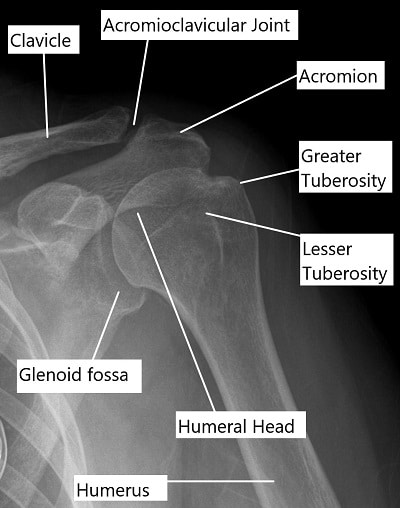AC Joint Pain
What forms the Acromioclavicular (AC) joint?
Acromioclavicular joint is formed where the collarbone(clavicle) and the uppermost part(acromion) of the shoulder blade(scapula) meet. AC joint although small but play a great role in the shoulder movements and stabilization.
The AC joint like all joints contains a white tissue (cartilage) which functions like a ball bearing not only helping in the gliding movement but also reducing friction and preventing the two bones from crushing against each other.

X-ray of the shoulder joint.
The gliding movement of the AC joint facilitates and forms an important link in the overhead movement of arm. The joint is also held together by strong and taut tissues(Ligaments) between the collar bone and parts of the shoulder blade (acromion and coracoid process) which prevent the joint from separating.
Affections & Symptoms of the AC joint
The affections of the AC joint cause undue pain and morbidity in the shoulder. The pain is usually located at the top of the shoulder, especially during activities which involve reaching overhead (like an overhead shot in tennis or reaching to pick something from the top shelf) or in activities where you might want to move your arm across your body like fastening a seat belt or even zipping/unzipping your dress behind. Common conditions are either traumatic separations/fractures or arthritis. Overuse is one of the culprits, especially among young athletes like tennis players, heavy weight lifters, overhead throwers or even active adults who bench press.
Traumatic joint separation is more common in contact sports like football or soccer and a more sudden onset with pain and swelling may point towards infection.
Arthritic pain can be secondary to a traumatic event or develop due to age related joint degeneration called osteoarthritis. Osteoarthritis of AC joint occurs due to loss of the white tissue(cartilage) in between the joint and subsequent bony spurs form which grind as the joint move irritating the joint and surrounding tissues causing pain, especially with overhead activities and moving arm across your body. Moreover the osteoarthritis can impinge and irritate the tendons(rotator cuff) of the shoulder joint further adding to the pain, especially a sharp pain occurring at the outer upper arm which is worse at night.
Diagnosis
Early diagnosis is not only important to halt the disease process but also to preserve shoulder function. Your physician apart from taking detailed history about your restriction of activities, shoulder injuries, systemic diseases, family history will also conduct physical examinations to assess your shoulder pain and instability. The physician might inject a local anaesthetic in your AC joint to assess response and aid in diagnosis. Further a radiograph(X-ray) might be needed to see for any fractures or bony abnormalities sometimes even warranting a CT scan.
Usually an MRI is helpful to look for inflammation and condition of structures surrounding the joint, especially tendons and ligaments.
Treatment
Usually Nonoperative modalities are the first line of treatment. These may consist of activity modification, anti-Inflammatory medications, physical therapy and steroid injections.Activity modification involves avoiding the positions precipitating pain and among athletes modifying the activity.
Anti-inflammatory drugs can also be prescribed which are helpful in reducing pain, inflammation and swelling have side effects like acid reflux and ulcers etc ruling out their long term use. Steroid injections are quite helpful in completely alleviating the symptoms at times. They usually provide relief for many months after which they may be repeated.
Injections in AC joint are challenging and your physician might use ultrasound guidance.Physical therapy forms the mainstream part of both nonoperative and operative management and helps in early rehabilitation and return to sports. Operative management will depend on the underlying cause and diagnosis.
In cases of osteoarthritis of AC joint Arthroscopic Surgery can be performed where the physician will insert a minute camera along with tiny instruments through small incisions around the shoulder. The surgery will remove the damaged cartilage, bony spurs(osteophtyes) and sometimes a very small part of the collar bone forming the joint to reduce friction.
One added advantage is visualisation of the bigger shoulder joint(Glenohumeral) to diagnose any abnormalities. The surgery is usually day care and promises a faster rehabilitation.
Other surgical techniques involve a small incision(usually an inch) over the joint and may involve resecting a part of collarbone or stabilizing the collar bone with the upper part of the shoulder blade with screws or sutures in case of separation of the AC joint or instability. With surgical management majority of patients are pain free and return to their previous activities and sports.
If you have any of the above mentioned injuries or experience pain, consider visiting an orthopaedic surgeon with specialities in arthroscopic procedures.

Dr. Robert Rhodin
As one of the orthopedic surgeons here at Complete Orthopedics, I
specialize in sports medicine, and problems of the shoulder, knee, hip, neck
and spine. I approve this content, and have written either all or most of it myself. Read more about me at my profile page.
